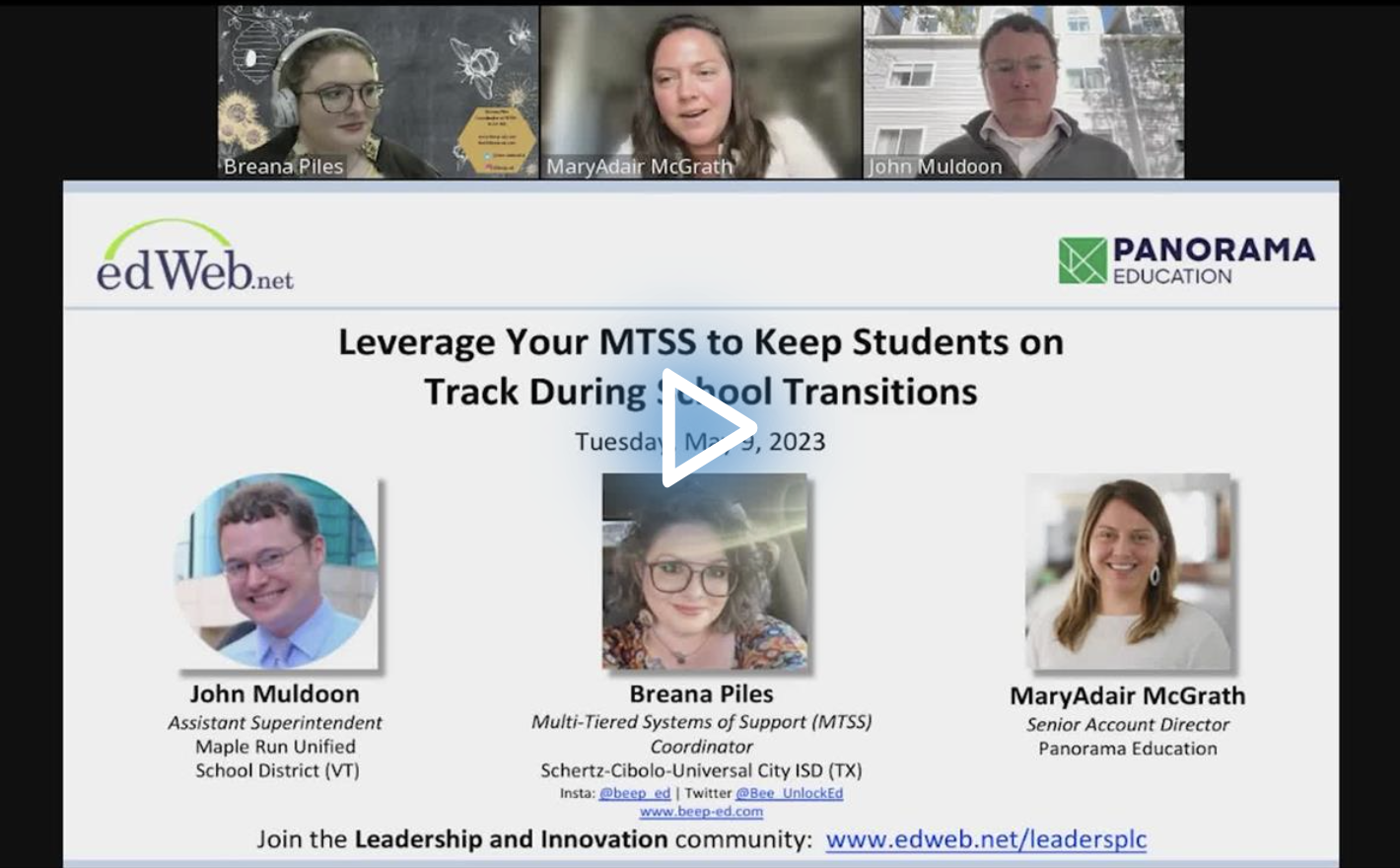Leveraging MTSS to Support Students During School Transitions
Watch the Recording Listen to the Podcast
The end of the school year marks a big transition for students at all levels. Many prepare to make the jump from elementary to middle school, middle to high school, or even between districts. With so many students moving from one place to the next, keeping them on track presents a challenge for district leaders and educators alike.
Statistics show that more students fail ninth grade than any other grade, emphasizing the need for proactive support and planning during transitional periods. As educators and district leaders begin planning for the next school year, it’s crucial to set up a Multi-Tiered System of Support (MTSS) to track students’ progress.
Identifying important indicators for student success, flagging predictors and indicators for struggling students, and defining clear plans for transitions are all important steps in creating a fail-proof system where students are set up for success from day one.
During the edLeader Panel, “Leverage Your MTSS to Keep Students on Track During School Transitions,” district leaders discussed how their districts implement MTSS to proactively plan for transition periods.
The first step in setting up an MTSS is to set up a system that collects data on students’ well-being and academic progress throughout the year. Schertz-Cibolo-Universal City Independent School District uses Panorama’s Social-Emotional Learning (SEL) Survey, which they administer three times throughout the year.
Behavioral records, attendance, and grades are also equally important to track—in fact, academic failure is the biggest predictor of students’ struggles the following year. At the beginning of the year, they use a set of guiding questions that determine which students are at high risk for academic, social, or both.
Some SEL indicators that have been especially important for the district are Sense of Belonging, School Safety, and Teacher-Student Relationships. They measure how the trends fluctuate over time using the Panorama Platform, which allows district leaders to aggregate the data and see the overview of social, physical, and academic progress.
This permits school teams to stage individual student interventions, as well as set school policies at a macro level when trends begin to emerge. Additionally, this lets stakeholders leave comments and document student plans over time, which makes the “handoff” between schools seamless.
The implications of gathering data and having a platform to track it mean that new schools don’t have to recreate the wheel when new students begin. John Muldoon, Assistant Superintendent of Maple Run Unified School District (VT), said it best when he said tools like these have allowed their district to “turn on the tap and let the data flow between schools.”
When time is of the essence, and there has already been a strategy that has helped the child be successful, the new school can pick up right where the last one left off and continue to support the child so they don’t fall through the cracks.
Specifically, one way an MTSS can support students who are lagging behind is by collecting and analyzing prior attendance, academic, and report records. Having the data and seeing previous patterns lets new teachers proactively engage the appropriate stakeholders. At meetings between students, parents, and teachers, having a dashboard with relevant indicators also allows stakeholders to visualize where the problems are most prevalent.
This has empowered teachers to lead more meetings and get ahead of the curve to support students and has also freed up administrators’ time to focus on big-picture school policies. Overall, it allows teachers to focus on the kids and administrators to focus on improving school climates.
Having this data can allow districts to intervene in other ways to support students, too. Districts like Maple Run have created summer camps to support at-risk students and their families during transitional periods. Literacy programs and reading initiatives have been especially popular, and have targeted children who are at risk for learning loss. Local pediatric clinics have donated books and services to struggling students during school vacations.
Gathering many data points in one place also allows district leaders to better address community concerns and advocate for the resources they need. Recently, Maple Run got their budget approved by a historically wide margin because they were able to show concrete numbers about their students’ progress. Clearly, collecting data at this scale is important when bringing schools into the 21st century.
It’s undeniable that data can help schools build informed and targeted Multi-Tiered Systems of Support for students and families. Dashboards, surveys, notes, and reports can help educators accompany students as they pass through difficult life transitions and set them up for success as they transition between the phases of schooling. By leveraging the power of well-thought-through Multi-Tiered Systems of Support, schools can empower students to navigate transitions with confidence, ensuring their continued growth and success.
Learn more about this edWeb broadcast, “Leverage Your MTSS to Keep Students on Track During School Transitions,” sponsored by Panorama Education.
Watch the Recording Listen to the Podcast
Join the Community
Leadership and Innovation is a free professional learning community that serves as an online forum for collaboration on leadership and innovation in schools to meet the needs of the next generation.
 Panorama Education partners with K-12 schools and districts across the country to collect and analyze data about social-emotional learning, school climate, family engagement, and more. With research-backed surveys and a leading technology platform, Panorama helps educators act on data and improve student outcomes. Panorama supports 15 million students in 21,000 schools and 1,500 districts across 50 states.
Panorama Education partners with K-12 schools and districts across the country to collect and analyze data about social-emotional learning, school climate, family engagement, and more. With research-backed surveys and a leading technology platform, Panorama helps educators act on data and improve student outcomes. Panorama supports 15 million students in 21,000 schools and 1,500 districts across 50 states.
Blog post by Laura Smulian, based on this edLeader Panel





Comments are closed.